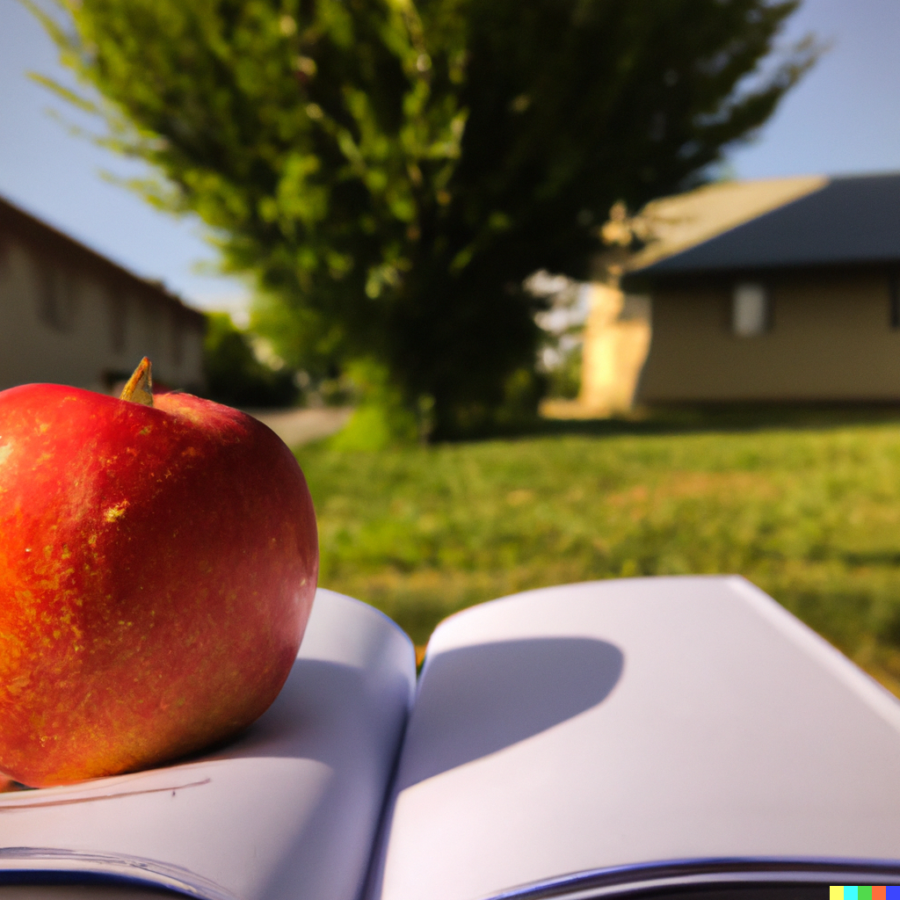Future Races Ahead, High Schools Left Behind
January 19, 2023
We believe that high schools are having trouble keeping up with modern technology, and the skills to use it. Below are three articles that describe the problem, and how we can fix it.
Side note; all images were created by DALL-E, an image generation AI, and are captioned with the prompt that was used to create them. AI images fall under the creative commons license.
What Are the Facts?
Technology is improving at an exponential rate. While colleges and the workforce are keeping up with these improvements, high schools seem to be left behind.
Current New Hampshire requirements dictate that only half a credit for computer education is necessary for high school graduation, according to Learning Path. This means that students are required to participate in computer education for ~1.8% of their 9-12 education. Hollis Brookline substitutes this requirement for the ICT Digital Portfolio, which is automatically compiled by the school, and therefore requires no input from the student.
This lack of compulsory computer education creates some amount of dissonance between the high school curriculum and what kind of skills are needed in the wider world. The last major steps that high schools have taken to keep up with the modern digital age was to implement personal school laptops and Google’s education tools.
Educause held a panel on 2019 – 2020 IT issues in education, which highlights how higher education in the United States has begun shifting towards more digital learning models. They found that only about 17% of surveyed institutions were dedicating no effort towards digital transformation.
Even the application process has become almost completely digital, so students need a strong understanding of College Board’s and Naviance’s online tools.
The Educause panel also discussed artificial intelligence. AI in recent years has become much more advanced, allowing it to completely automate menial tasks. Today AI is able to completely fabricate original images, both realistic and artistic, and produce original works of creative writing. What this means for humans is that we must advance our own average knowledge of technology and how to use it, to ensure that AI doesn’t completely replace the majority of human laborers.
In 2017, the Brookings Institution conducted a study on the increase of digitalization in the workforce from 2002 – 2016. They found that while the share of the workforce that used medium digital skills rose by 8%, the section that required high digital skills nearly quintupled from 5% to 23%. It goes without saying that the share of low digital skill jobs available decreased in that time, by about 26%.
The Brookings study also found that the Boston-Cambridge-Newton metropolitan area had the second highest mean digital score (determined by how many jobs require digital skills, and to what degree) for the United States workforce, after Silicon Valley. Students who are educated in New England should be required to learn advanced digital literacy skills to keep up with the part of the workforce that they will likely join.
Everyday life has been heavily infiltrated by technology, from shopping to entertainment. Denial is no longer an option. That’s why high schools should make an effort to help students embrace technology and teach them how to use their devices to the fullest.
How Do High Schools Keep Up?
Prompt: photo with a school book in the foreground, with a blurry, out of focus highschool in the summer with warm lighting at noon and apple trees around it
Imagine walking into a classroom and seeing a line of computers, or even virtual reality headsets replacing the desks and notebooks that make up today’s classrooms.
For some, this thought isn’t necessarily appealing, but the reality is that as jobs of the future require more and more technology, students and schools alike are going to have to learn how to adapt to these changes.
This could start with schools changing their approach to cell phone and technology policy.
“Rather than ban devices, why not incorporate technology into the classroom? In the workplace, phones and other technologies are readily used – so it makes sense that learning how to manage them and get the most out of what they can do should start in schools to prepare them for their future in a technology driven world” (“The Importance of Connecting Classrooms to the Real World”).
In addition to these changes, high schools like HB need to offer classes that can directly prepare students not just for jobs, but also for college.
Classes like Artificial Intelligence, Machine Learning, Data Sciences, Robotics and Automation can all be hugely beneficial to students interested in trying out these options before deciding that they want to study them in college.
“In high school, students can attempt an activity or a subject and determine that it isn’t their favorite; however, once a student is pursuing a major in college or professional career, deciding the topic or industry is no longer of interest has greater consequences” (Beta Bowl).
I am personally aware of several students, including myself, who are considering going to college for a career they have never even tried before. This is detrimental to student’s lives, as they might pay for a tuition they don’t actually enjoy, or even wish to pursue.
Therefore it is critical that HB offer these classes to give students a chance to test things out before they commit themselves to a degree for the next few years of their life.
The Davidson Academy of Nevada offers classes like Quantum Mechanics and Machine Learning/AI that teach students how to use new technologies and allows them to test out potential careers at the same time.
Hollis Brookline should follow suit, not only by introducing new classes, but also by considering an adjustment to their technology policy.
How Are New Courses Implemented?
Many courses to schools have been added that tap into the creative and individual side of students like journalism 2, science fiction studies, advanced writing and film studies. All of these classes that many students take were simply ideas that people came up with and proposed. These are the steps and requirements needed in order to propose your own class!
When adding a new class to the school curriculum, there are two different types of ways that they can be implemented, as an elective or as a core class.
With implementing an elective course into the curriculum, one of the first things is to create a yearly or semester-long schedule and to list all of the items needed for said class. The elective will fall under the jurisdiction of a department of the school depending on what the pitched class idea is.
“Each department is responsible for their classes and what classes they offer, each has a head that has the final say but all members of the department will discuss it,” said school counselor Emily Thompson.
After passing by the department, the proposed class is forwarded to the administration of the school. Assistant Principal Amanda Zeller is the current head of the curriculum administration during the writing of this article. “You usually think of Zeller as the discipline of the school, but the curriculum is her ballpark,” Thompson said.
Discussions rely on whether the school needs the class, the popularity and size of the class, availability of classes, and teachers who have expertise in the subject to teach or budgeting for new teachers if needed.
With a core class being added to the curriculum, it’s the same steps as an elective class, but also needs to be approved by other organizations than just the school, some organizations are the NCAA and the Department of Education as adding a core class has a more rigorous curriculum and would need more class space and teachers as many students would take it compared to an elective.
In recent years, there have been many people who have studied computer science and pursued more technical degrees, so the search for a technology major teacher would be a more varied search. Many instructors can teach things like life skills and technology use within the workforce.
As schools have slowly opened up from the COVID-19 pandemic and begun rebuilding, now is a great time to discuss and attempt to improve from the current curriculum and really focus on what’s important and how to succeed in society today.



